Month one: Kia to the city
Price as tested: $64,990 (driveaway) Fuel this month: 326km @ 9.4L/100km
Is it possible the Koreans didn’t get the memo about the death of diesel?
The least-refined member of the petroleum family continues to fall out of favour around the world, yet Hyundai has just launched its all-new 3.0-litre turbo-diesel in-line six in the Genesis GV80 SUV, while here we have a new alloy-blocked version of Kia’s 2.2-litre turbo-diesel four.
According to Kia, it’s expected to be the volume seller in this, the all-new fourth-generation Kia Sorento.
Just for the record, I didn’t choose the diesel over the alternative, which is the venerable 3.5-litre non-turbo V6. That decision was made for me, due to timing and availability.
In fact, I’ve not yet driven the V6 version, so I’m left to speculate as to what I’m missing out on. I do know that choosing the V6 saves $3000 in top-spec GT Line, but means forgoing AWD, as it’s engineered for FWD only.
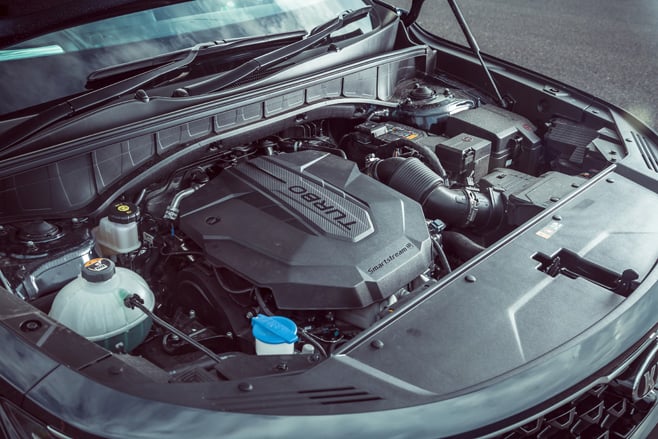
I’m predicting it would mean a smoother, quieter idle – the weakness of this diesel – but on paper, its max torque of 332Nm occurs way up at 5000rpm, which would mean working it hard to match the effortless pull of the oiler, which grunts out 440Nm at just 1750rpm, and holds onto most of that until well past 3000rpm.
As a quick aside, these two powertrains won’t be the only choices offered to Aussie Sorento customers. Two hybrids – one series, one plug-in – are set to join the line-up in the first half of 2021, meaning four powertrain choices, along with four equipment levels (though not all interlinked). I’m especially keen to try the plug-in, and will make a comparison with it and the diesel the subject of a latter instalment here.
The other thing I’ll sort through is the value-for-money equation when applied to the equipment level. This handsome metallic blue GT Line is $64,990 (driveaway) making it currently the most expensive model.
The rung below is occupied by the Sport Plus, which saves you $7500 in diesel AWD guise, but does away with the 20-inch wheels (it gets 19s), the mood cabin lighting, glass roof, Bose audio, self-parking function and blind-spot cameras, among some other bits.
We’ll circle back to that next month; as I wrote in the first drive of this car this really does feel like Kia’s coming-of-age model; one that finally banishes that attached proviso: “…for a Korean car.”
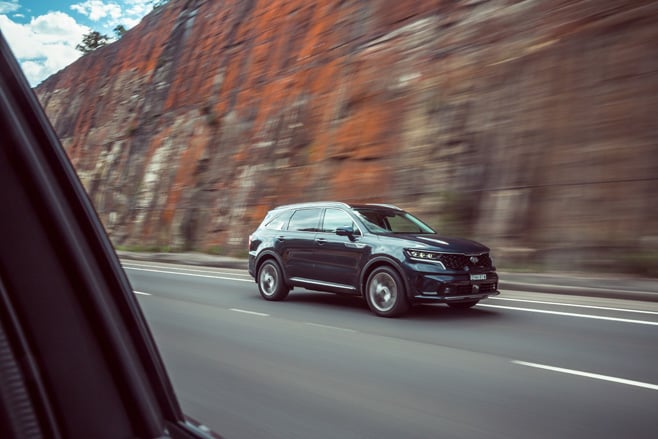
It really is an impressive family SUV, despite needing to overcome the fundamental NVH disadvantage of a diesel four, as well as an out-of-favour eight-speed dual-clutch transmission.
Personally, I have no practical need for a seven-seater, yet I still find myself walking up to the Sorento and admiring its chiselled exterior and confidant stance. I’m not alone; so far it’s attracted only positive comments from curious punters. Which continues when you swing open the door. I’d love to whack a bit of gaffer tape over the Kia badge on the wheel and ask a dozen people who have a passing interest in cars to each tell me what brand they think they’re sitting in.
Sure, when you really scratch and sniff your way around the cabin, you’ll see the materials that look like aluminium are plastic, but countering that is the level of design and consideration that’s gone into every detail, as well as the utter intuitiveness that runs through the whole car.
You hear companies like Mazda bang on about ‘human-centric design’ as if it’s a bold breakthrough (who were the cars designed for prior to this? Panda bears?) whereas Kia just gets on with the task of making every function feel intuitive, with no exploration nor explanations needed as to what does what or why.
Jeez, listen to Mister Practical Motoring here. I’ll go now and try to find something to whine about and see you back here next month.
Month two: Take it from the top
The flagship model is lovely to have, but essential?
Price as tested: $64,990 (driveaway) Fuel this month: 765km @ 8.9L/100km Total: 1091km @ 9.0L/100km
Questions I’m rarely asked include, “How do you maintain such a deep golden tan all year round?” More frequently, though, I’m quizzed about model grades and options packs.
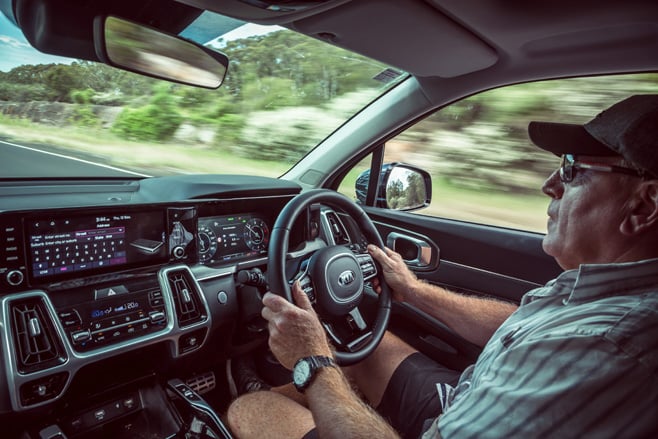
Prospective buyers often seem in a mild state of anxiety over which model in the line-up to choose, and what extra equipment they should make sure is fitted.
It’s classic FOMO syndrome, not just prompted by what they may miss throughout the ownership experience, but also the worry that their car will end up seeming under-equipped and dated come resale time.
In the case of the Sorento, the options issue is not really an issue at all, because apart from paint there aren’t any. You either settle for white at no cost or stump up $695 to choose from one of six metallic colours. Done.
But the question of which of the four spec levels to choose isn’t as straightforward. The good bit is that the diesel four and petrol V6 are both offered in all grades, but that doesn’t mean you can please all the people all the time.
I was approached the other day for a chat by a guy who told me he was expecting delivery of his diesel GT Line in a few weeks. Turns out diesel wasn’t his preference; he wanted the petrol, but not when he learned it was available as front-drive only. His family were frequent visitors to his in-laws, who lived rurally off a steep five-kay access road that was often muddy, so AWD was a must-have.
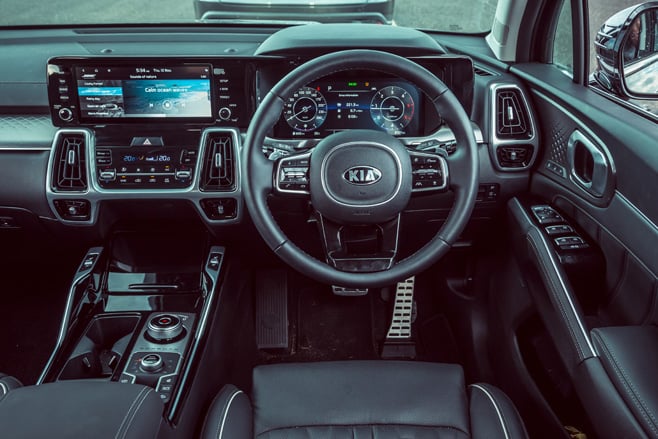
But then he hit me with the question I was hoping to avoid: “Reckon I made the right choice going for the GT?” Knowing it was a done deal, naturally I said, “Oh yeah! Absolutely!” But truthfully it’s not that clear-cut. As is often the case with top-spec models, the extra kit is nice to have but doesn’t necessarily transform the ownership experience.
Here’s my snapshot of the usefulness of the extra equipment that adds $7500 to my GT Line over the Sport+ below it. The 20-inch wheels look great but don’t help the urban ride, so they could go. The autonomous parking function is a cool trick, but I’m yet to find a jammed-in scenario in which to use it. Similar deal with the blind-spot cameras.
That leaves the vast glass roof, which I occasionally remember to use at night, the mood lighting (Yeah, baby!) and the 12-speaker Bose audio, which is a huge improvement over the standard six-speaker system fitted to the three models below.
Overall, I reckon the extra definitely justifies the cost, but if spending that additional $7500 is going to mean feeding the kids pet food for the next few years, the Sport+ in no way leaves you feeling short-changed.
Month three: Diesel… dust
Getting down and dirty to determine the merits of all-wheel drive
Price as tested: $64,990 (driveaway) Fuel this month: 105km @ 9.2L/100km Total: 2096km @ 9.1L/100km
I reckon there’s a broad rule of thumb that can be applied to the essentialness of all-wheel drive on cars and SUVs. If the platform is fundamentally rear-drive, you can almost surely do without it, if you’re happy to live on the edge.
Witness the Porsche 911 GT2 RS versus Turbo S, or Lamborghini Huracan LP-2 models.
However, if the platform is born as a front-driver, there’s every chance you do want AWD; evidenced by Golf R versus GTI, or a bunch of fast AWD Audis versus their front-drive counterparts.

This thinking carries over to the Sorento. It’s a front-drive platform that really does benefit from AWD.
Without giving too much away about 2021’s COTY coverage, our testing gave us plenty of time to evaluate the field on closed dirt roads within the proving ground.
Now, while this is a great way to really probe a car’s traction, ESC and ABS calibration, I’m not going to pretend it isn’t a ridiculous amount of fun, either.
Sometimes the biggest challenge is keeping a steely face for the photographers when, on the inside, you’re whooping like a teenage girl at the Magic Mike stage show.
Well, at least that’s me when a car’s ‘ESC off’ button actually does what it claims. In the Sorento, as with plenty of other SUVs, ‘ESC off’ is not off at all, merely a reduction of the threshold of intervention.
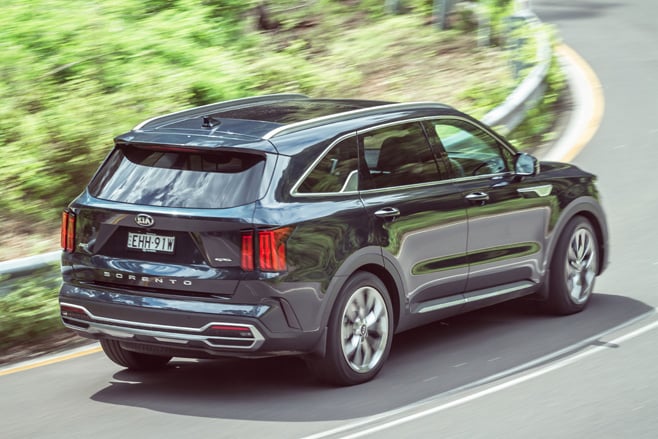
We had both the diesel AWD and V6 petrol front-driver at COTY, and in both cars the ESC calibration was about as lenient as arriving late to a booking with Madam Lash, instantly clamping down on the first hint of a slide and slow to release the brakes and restore throttle response once the loose moment had been regathered.
Switching it off helped things plenty, allowing a small amount of lift-off oversteer to tighten a line or hold a balanced throttle through faster sweepers with the car past the edge of traction.
But as for full freedom to really get the Sorento swinging and pivoting through the tighter turns, no chance.
I guess this comes down to how different car companies interpret corporate responsibility. It’s fair to argue that no-one really needs to be on the lock-stops on public dirt roads, and for most buyers in this segment, the whole analysis of loose-surface dynamics is going to be a moot point anyway.
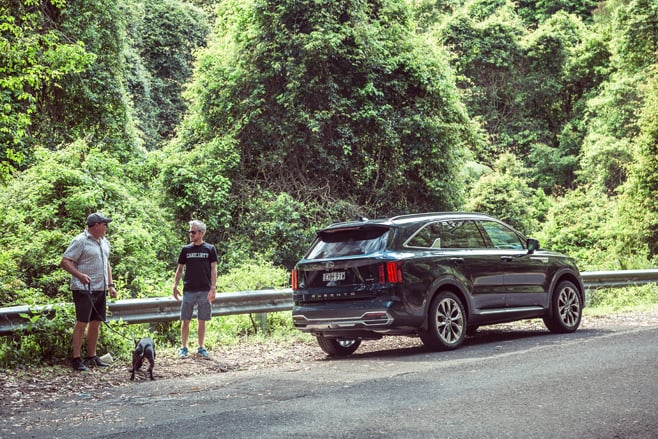
But it’s still interesting that some companies, like Mazda, tune their ESC to recognise competent drivers and not intrude when appropriate inputs for car control are being made, and provide an ‘off’ setting that really does mean off.
But back to the question of all-wheel drive; the dirt section of the proving ground was a conclusive demonstration of the effectiveness of the Sorento’s system when driven back-to-back with the petrol front-driver.
Even though the petrol V6 makes less torque than the diesel four, it still funnels sufficient twist to those front wheels to have them fairly overwhelmed with the power-down task on a loose surface. Generous helpings of throttle with steering lock applied brings quite violent axle tramp and sees the wheel writhing in your hands like a snake being wrangled by Steve Irwin’s mini-me kid.
The diesel suffers none of this, thanks to the AWD system’s ability to quickly funnel the torque rearward when needed, leaving the steering largely uncorrupted. It delivers a level of calm, power-down competence missing from the front driver.
So if you regularly drive on dirt or visit ski resorts in winter, the Sorento for you is definitely the diesel AWD. But if you’re diesel averse, don’t forget the hybrid 1.6-litre turbo-petrol four with electric assist is due in Australia in the first quarter of 2021. And, yes, it does drive all four wheels.
Farewell: Right moves, but it’s still time to go
Departing Sorento makes its case as the best car in kia’s australian line-up
Price as tested: $64,990 (driveaway) Fuel this month: 1203km @ 8.9L/100km Total: 3299km @ 9.0L/100km
We were about 20 minutes north of Newcastle, me and the Kia Sorento, cruise control holding us at an indicated 110km/h, the diesel four barely audible as it sipped at an indicated 7.2 litres per 100km. I was gathering together my final thoughts on Kia’s seven-seater, helped by a cranking Tidal playlist via Apple CarPlay, when a WhatsAp message pinged through from one of my more cerebral, deep-thinking mates. The Apple assistant helpfully asked if I’d like her to read it, which I did.
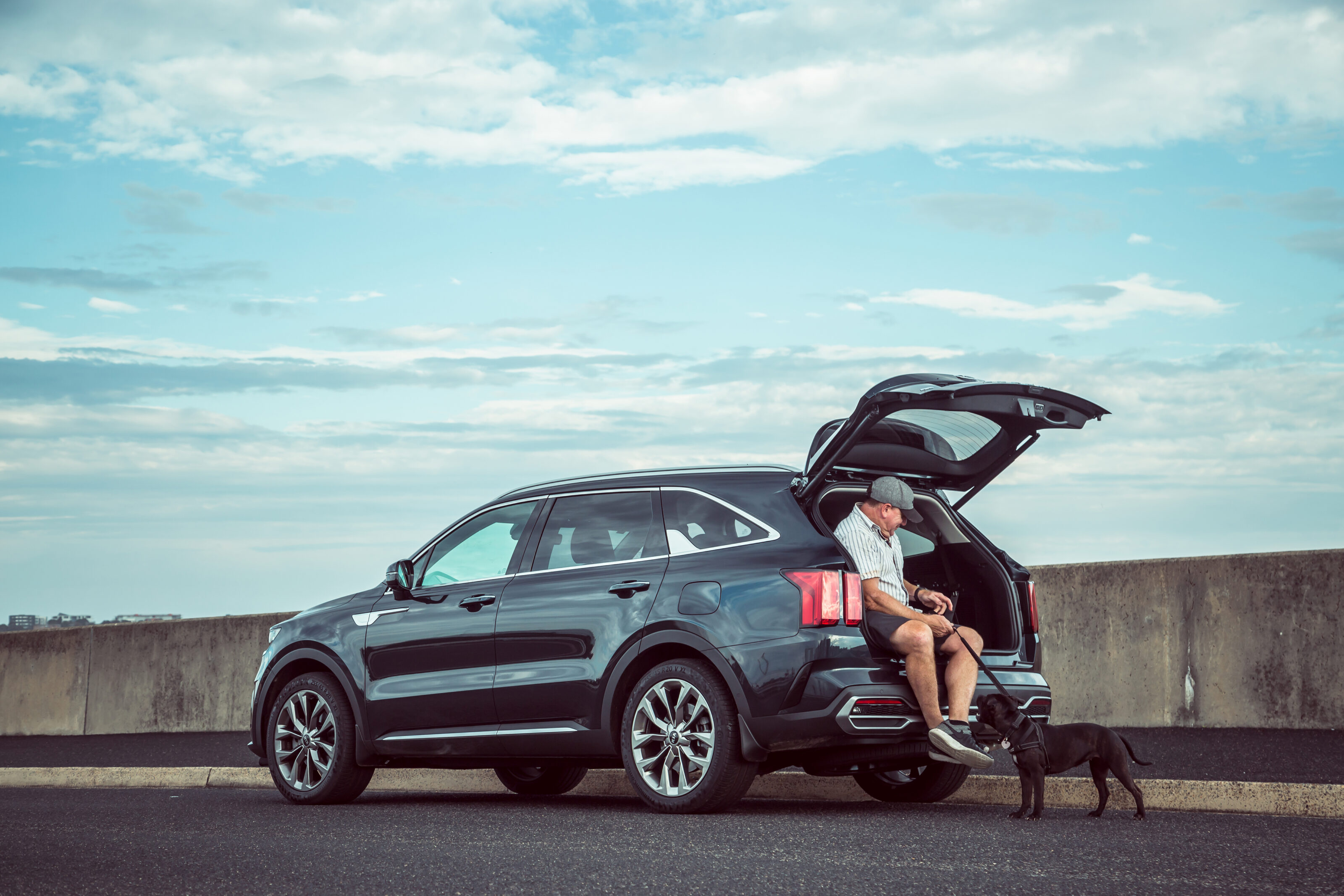
In her slightly staccato delivery, she said, “What would you prefer to fight: A giraffe-sized dog, or 100 dog-sized giraffes?”
It was a tricky one, especially as the stature of the dog-sized ‘gee-raffs’, as she pronounced them, wasn’t specified. Were we talking fox-terrier-sized? Or would I be dealing with 100 mastif-sized giraffes coming at me as one angry herd? I’d need more thinking time on this one.
One thing I didn’t need to ponder was the fact that the Sorento’s impending departure would leave a real hole. As motoring enthusiasts, I think we’re largely in agreeance that a large wagon beats a large SUV every time, however, if you occasionally need those extra two third-row seats, there simply isn’t a wagon on the Aussie market that can deliver such a layout. Further, I’ve grudgingly come around to the fact that an SUV’s extra ground clearance is useful for dealing with urban obstacles like steep driveways and parking space front kerbs.

So with that established, the other irrefutable fact is that the Sorento really is a great family touring wagon. It’s brilliantly quiet, calm and long-legged on a road trip, with a range of around 850km. But more than just that is the fact it has so few flaws to annoy you. The front seats are super comfortable and supportive, and with both heating and cooling, one’s butt is always temperate. Everything from the HVAC, to the nav, to the head-up display, works exactly as it should.
The steering is nicely calibrated to provide a decent sense of connection to the road, but is also never flighty or nervous, no matter what the road condition. As for the ride, I still reckon it’s a fraction too nibbly and reactive at suburban speeds, but in touring mode, the chassis has great absorbency and real composure.
The safety stuff was less equivocal. Rear-cross traffic alert was frequently useful, but I found the lane-keep function too intrusive and inconsistent, and requires a dig into sub menus on each start-up to disable it.
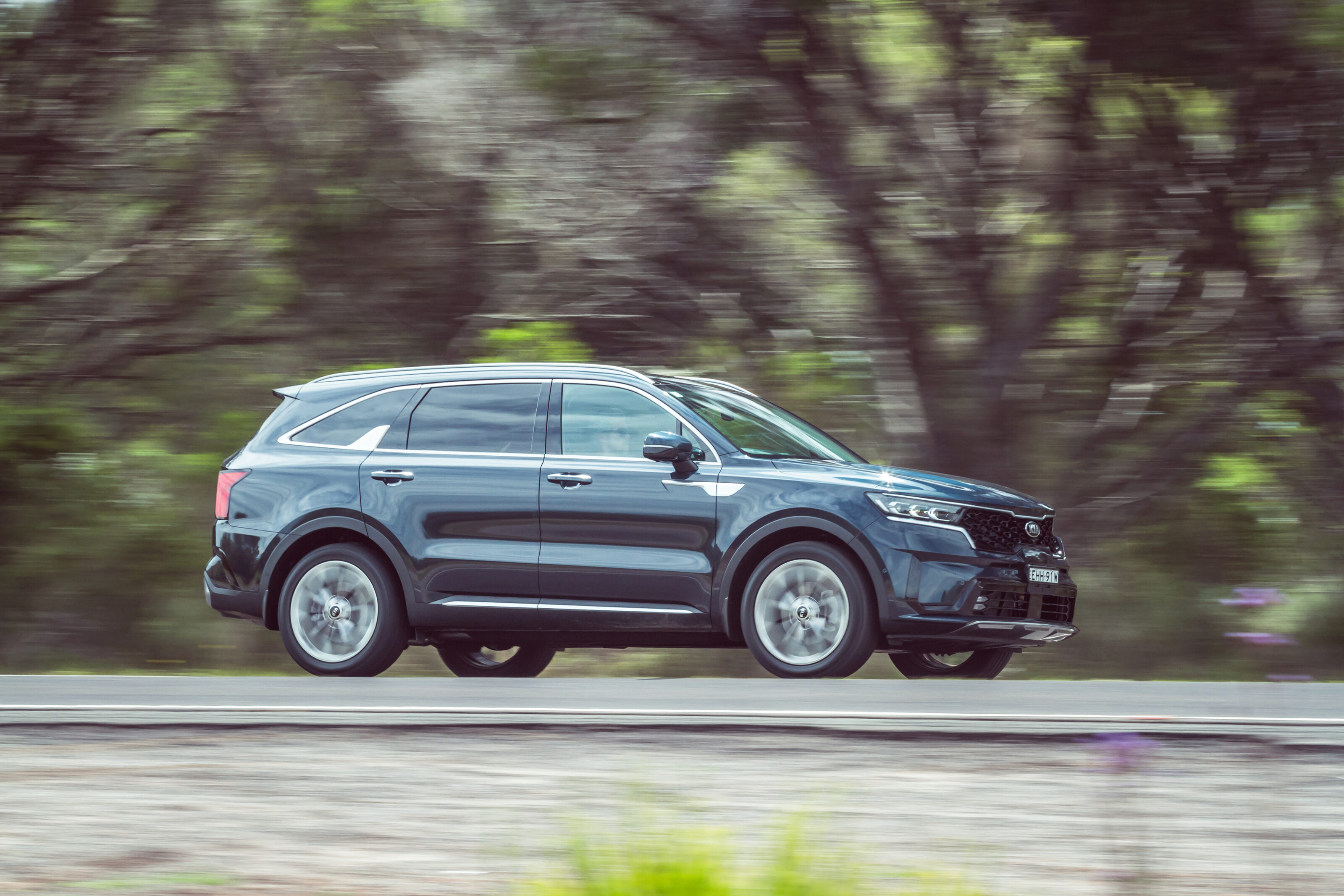
Of the extra equipment that comes with this GT-Line spec, it was the Bose audio I appreciated most. Like any good system it’s super revealing of the source material, so DAB radio sounds good but not amazing. Stream high-resolution content, though, and it comes alive, with great punch, a convincing soundstage and properly solid, tight bass.
As for the slightly vibey idle I moaned about in my first update, it’s become fractionally less noticeable as the odo has moved past 5000km, yet is still an area that deserves some developmental attention.
But the fact that I don’t have a laundry list of areas that could benefit from attention – apart from the lack of the third-row airbags and engine NVH tweaking – is testament to how well Kia has nailed the seven-seater SUV brief in the Sorento’s fourth generation, at least with the diesel AWD line-up.
Hopefully the arrival of the hybrid-petrol model will allow Kia to more completely take the fight to Mazda’s CX-9. Meanwhile, I’m preparing for hypothetical combat with 100 very small giraffes. But they’ll have to bring the battle to me, because I’m without a car right now.
Special: A different motive
We switch from diesel to petrol power in Kia’s large SUV and weigh up the cost versus benefits
Price as tested: $61,990 (driveaway) Fuel this month: 403km @ 14.4L/100km Total: 403km @ 14.4L/100km
Allow us a quick recap, for those of you playing along at home who may have lobbed back in late from a commercial break.
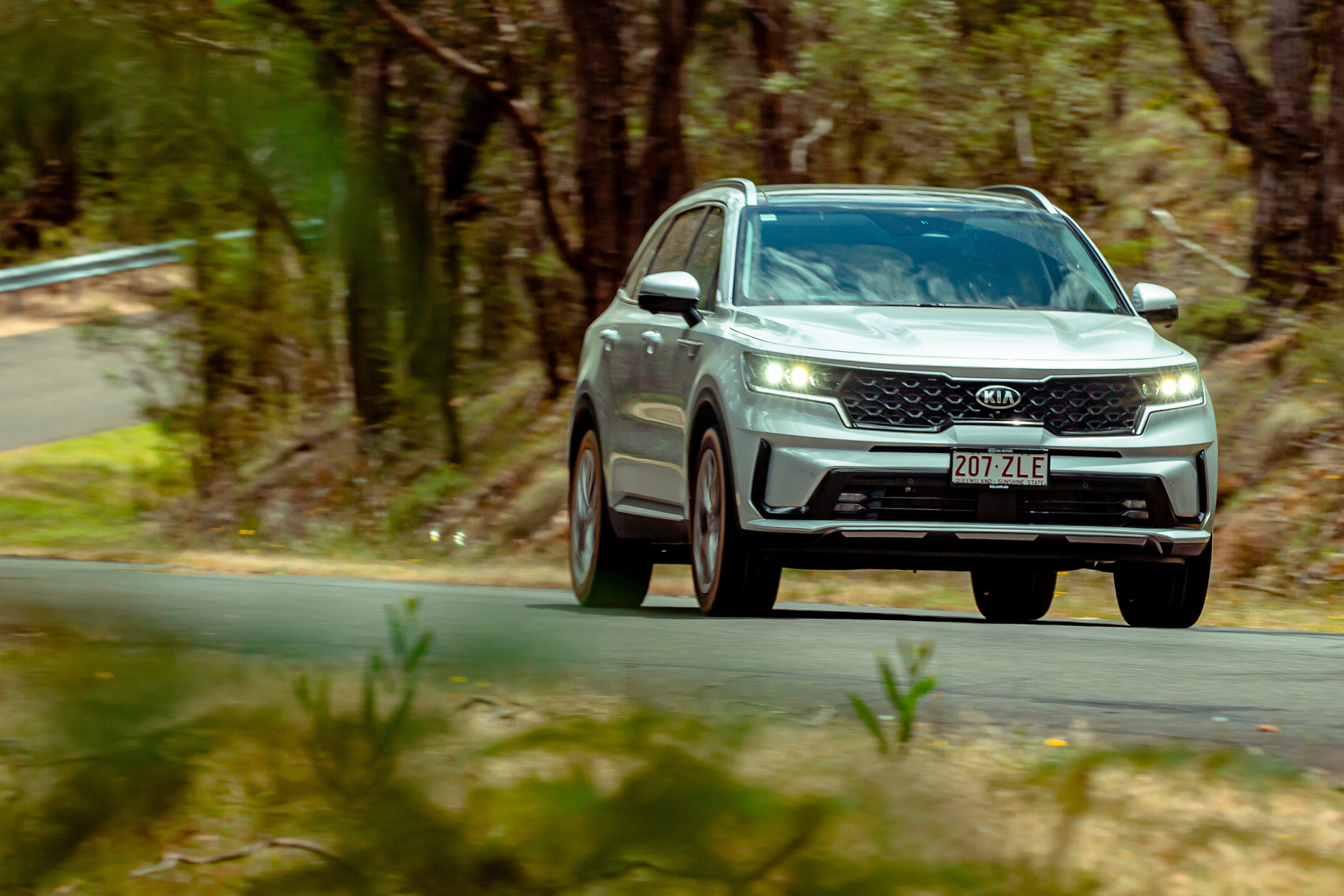
For the past four months I’ve been the custodian of a top-spec Sorento GT-Line diesel all-wheel drive, the Korean company’s flagship seven-seater SUV. Contrary to my default setting, I’ve been a largely non-grumbling one. That car ended its tenure last issue, with the only real caveats to its all-round goodness being no third-row airbags and the typical diesel NVH drawbacks. Not awful, but the vibey idle was at odds with the otherwise well-polished manners, and the level of clatter under modest acceleration, while not bad by four-pot-oiler class standards, still left room for improvement.
We knew from our most recent COTY testing of both engine variants that the V6 petrol version had no such drawbacks, thanks to the joyous combination of highly combustible unleaded fuel, a lower compression ratio and lively spark plugs. We also knew that as a front driver the V6 was less dynamically adept than its AWD diesel sibling. More prone to axle tramp and torque-steer; less composed and athletic on loose or wet surfaces.
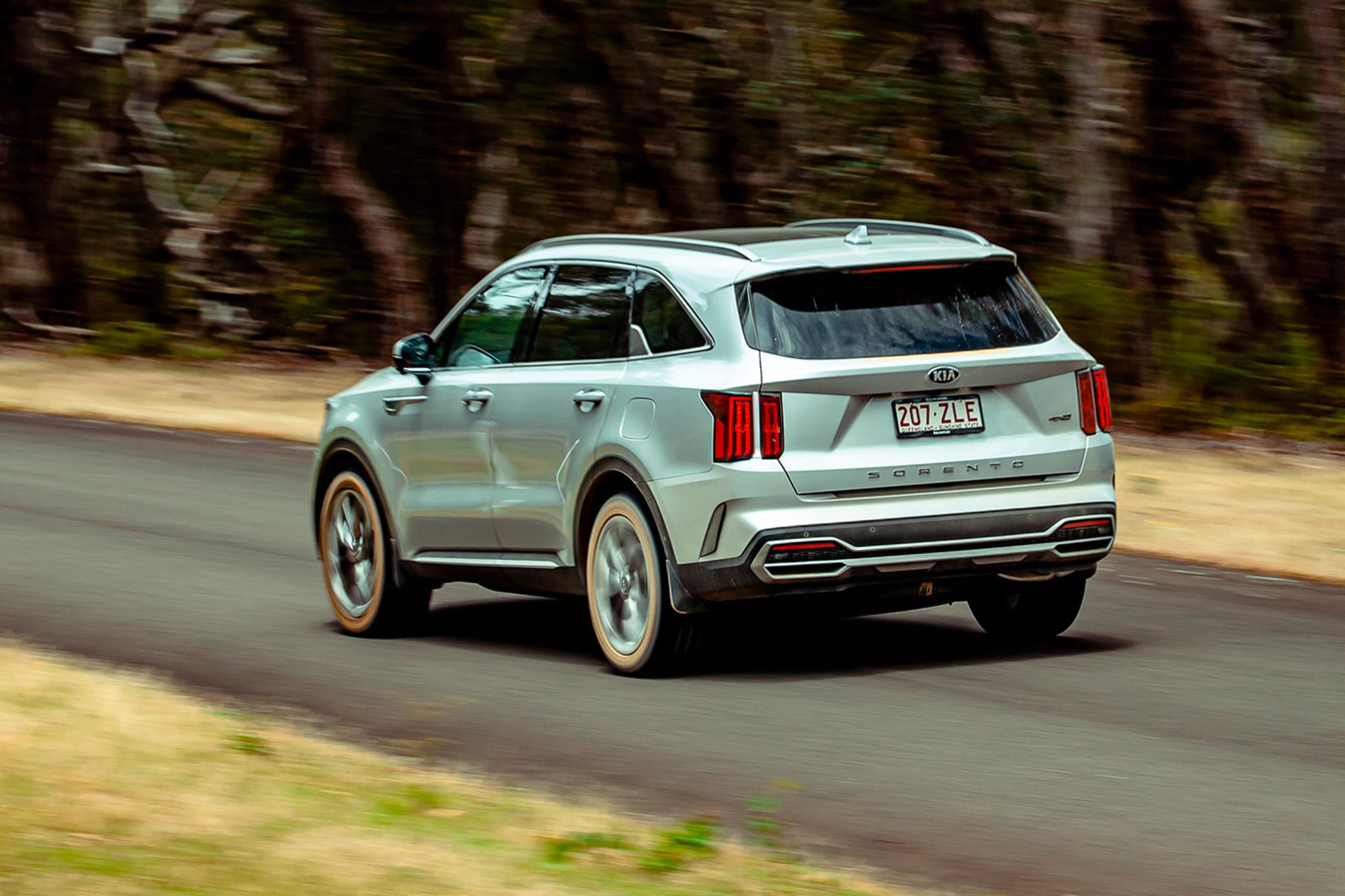
But we also understand that daily motoring life for most of you (and us) is pretty far removed from the relentless punishment of COTY testing. So when the opportunity emerged for me to spend a month with this top-spec GT-Line petrol front-driver, of course it was a fine idea. It’s a chance to see how it fares in more genteel real-world conditions (and keep me off Sydney buses where COVID probably lives) as well as allowing me to compare real-world consumption and running costs of diesel versus petrol.
But first, let’s take a hushed moment to reflect on the quietness of the petrol variant. It’s best appreciated stationary, ideally while treating the ears to some quality decibels from the excellent Bose audio system specific to GT-Line.
The car will only allow the accessories to run for a few minutes with the engine off, so an internal combustion accompaniment is unavoidable. In the diesel, during any quieter passage of music – like the Nirvana ‘soft-loud-soft’ signature that became a ’90s genre convention – the idle is ever-present; an inescapable background distraction.

In the petrol, this is replaced by the sweet sound of silence. I may be a bit NVH OCD, I’ll own that, but by any measure the V6 is beautifully muted at idle, with the gentle whisper of the ventilation and seat-cooling fans actually more audible than the lump under the bonnet. The lack of any vibration through the steering wheel is almost a bonus.
On the road, the V6 doesn’t have the effortless low-speed shove of the diesel, but it’s sure not lethargic, and again the more refined, attenuated aural experience is a compensation plenty will find persuasive. In normal driving, on dry roads, the front-drive layout isn’t an issue, especially in isolation and when not being compared back to back with the AWD model. Different story in the wet or on dirt, but I did cover that in the February issue so no need for further elaboration.
Instead, let’s get to the battle at the bowser, ignoring ADR consumption numbers and instead dealing with typical real-world scenarios.
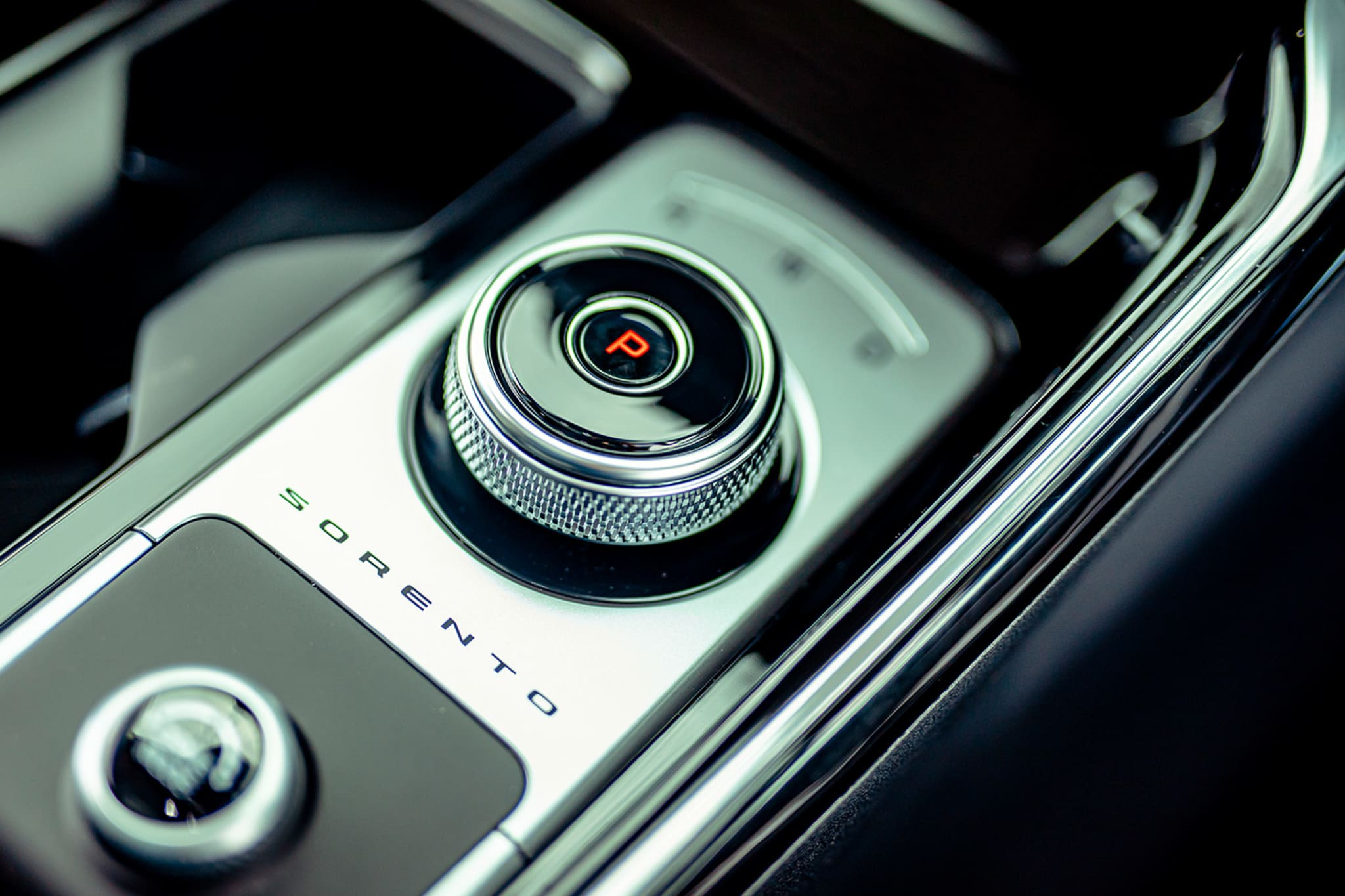
My overall consumption (mainly urban) in the diesel was around 9L/100km; in the same conditions, the petrol model seems set to settle around mid-14s. Both have tank capacities of 67 litres, so at current prices (diesel $1.27 and 95 RON unleaded $1.50), it costs around $85 to fill the diesel, translating to around $11.40 for every 100km travelled. In this petrol version, a fill is around $100, and the cost per 100km is nearly twice as much; a hefty $21.75 thanks to the double whammy of higher consumption and higher fuel price.
For the family doing, say, 350km per week, the extra cost of petrol will be around $36 over what the diesel owner is paying.
Don’t forget the diesel AWD models add $3000 to the Sorento’s purchase price (regardless of which of the four spec levels you choose), so it would take around 21 months for the fuel saving to pay for itself. But factor in slightly higher resale, longer touring range and the AWD security, no wonder the diesel is currently the bigger Sorento seller.






